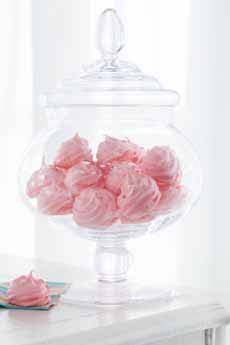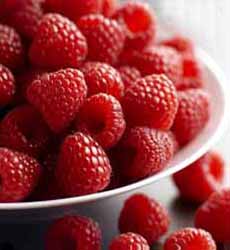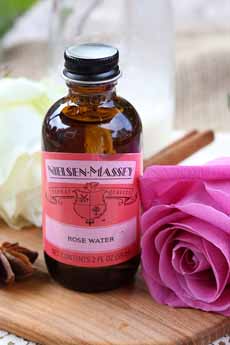RECIPE: Rosewater Raspberry Meringues
|
|
We so enjoyed the red wine meringue cookies we made for Valentine’s Day that we decided to make another pink, flavored meringue for Mother’s Day. This recipe, from Chef Ingrid Hoffmann, combines fresh raspberries with rosewater (also spelled rose water). You can jump to the recipe below. But first: Since ancient times, roses have been used nutritionally, medicinally, for religious purposes, to make cosmetics, and as a source of perfume. The ancient Greeks, Romans and Phoenicians considered their large public rose gardens to be as important as as orchards and wheat fields [source]. Culinary rose water is believed to have been first created in Persia during the Sasanian dynasty (224 to 651 C.E.). It was a by-product of producing rose oil (attar of roses) for perfume. It can be made at home, simply by steeping rose petals in water; and is available commercially. Here’s a recipe to make your own. If you’re making it to consume (as opposed to a skin refresher), use organic roses. You can buy a bottle in any Middle Eastern or Indian grocery, or online. In the Middle East and eastward to India and Pakistan, rosewater is used in, among other preparations: Rosewater is an ingredient in Waverly Jumbles, baked doughnut said to be a favorite of James Monroe, the fifth president of the United States (1817 to 1825). Today it is used by cooks around the world. For example, in Mexico it is used to flavor shave ice; in Yorkshire, England, it is still used in one of the area’s best-loved dishes, Yorkshire Curd Tart. You can add it to iced tea, iced coffee, smoothies and soft drinks; or make a Rose Martini. Needless to say, if you buy a bottle to make these meringues, you won’t have any trouble finishing the bottle. Ingredients For 5 Dozen Meringues |
|
|
Preparation 1. POSITION the racks in the upper third and center of the oven and preheat to 250°F. Spray 2 large baking sheets with cooking spray (to help secure the parchment) and line the sheets with parchment paper. 2. WHIP the egg whites and salt together in a large, grease-free bowl with an electric hand mixer set on high speed, until they form soft peaks. Gradually beat in the sugar and raspberry gelatin powder and beat until the mixture forms stiff, shiny peaks. Fold in the rosewater and vinegar. 3. TRANSFER the meringue to a pastry bag fitted with a ½-inch-wide star tip. Spacing them about 1 inch apart, pipe 1-inch-wide meringues onto the lined baking sheets. Bake until the meringues look set, about 1 hour. 4. TURN off the oven and let the meringues completely cool and dry in the oven. Carefully lift the meringues off the parchment and store them in an airtight container. These are fragile cookies, so don’t pack them tightly. We protect each layer with wax paper or parchment. Some sources say that that meringue was invented in the Swiss village of Meiringen in the 18th century, and subsequently improved by an Italian chef named Gasparini. The one fact we can hang on to is that the name of the confection called meringue first appeared in print in Chef François Massialot’s seminal 1691 cookbook, available in translation as The court and country cook…. The word meringue first appeared in English in 1706 in an English translation of Massialot’s book. Two considerably earlier 17th-century English manuscript books of recipes give instructions for confections that are recognizable as meringue. One is called “white biskit bread,” found in a book of recipes started in 1604 by Lady Elinor Poole Fettiplace (1570-c.1647) of Gloucestershire. The other recipe, called “pets,” is in the manuscript of collected recipes written by Lady Rachel Fane (c. 1612–1680) of Knole, Kent. Slowly-baked meringues are still referred to as pets in the Loire region of France (the reference appears to be their light fluffiness, perhaps like a kitten?). Meringues were traditionally shaped between two large spoons, as is often still done at home today. Meringue piped through a pastry bag was introduced by the great French chef Marie-Antoine Carême (1784-1833—he preferred to be called Antonin), the founder of the concept of haute cuisine. He also invented modern mayonnaise, éclairs, Strawberries Romanov, and other icons of French cuisine. Even though he wasn’t in on the beginning, he perfected the end. ________________ *Contenders from include 1700 on include, from the Walloon dialect, maringue, shepherd’s loaf; marinde, food for the town of Meiringen (Bern canton, Switzerland), is completely lacking. None of the others sounds right, either. By default, we like the Latin merenda, the feminine gerund of merere to merit, since who doesn’t merit a delicious confection? But as our mother often said: “Who cares; let’s eat!” |
||





